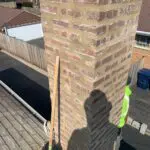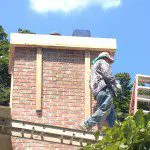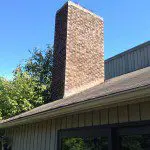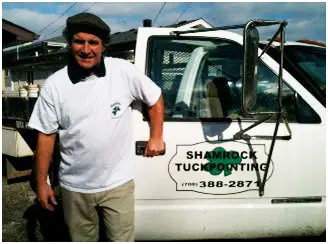05 Oct 2024
Do you need a chimney inspection?

In addition to having the inner workings of your chimney examined, the exterior of the chimney should also be inspected.
Inspect the exterior of your chimney for loose, missing, cracked or damaged flashings — the sheet metal that keeps the intersection between the chimney and roof watertight. These are common sources of problems. Deteriorated flashings should be replaced. If the flashing looks to be in good condition, recaulking should take care of the problem. However, caulk is not a substitute for flashing materials that do not overlap properly.
Also closely inspect the chimney’s brick and mortar joints for signs of wear. Chimneys as well as parapet walls are more exposed to the elements than brick walls so they will be the first to show signs of wear. To avoid major chimney rebuilds make minor chimney repairs as soon as problems arise. Professional chimney repairs will provide peace of mind for the homeowner or business.
Shamrock Tuckpointing has been serving customers in Chicagoland for more than 30 years.
Contact us for a free estimate on chimney repairs, tuckpointing or caulking.

The least expensive repair involves resurfacing the crown. This is only suitable when the crown damage is limited to multiple hairline cracks. We apply a product that seals the masonry, keeping water out and preventing the cracks from deepening. The average cost for resurfacing a chimney crown is $400.
When more extensive damage has been inflicted on the chimney crown, replacement is necessary. To complete the job, the old chimney crown needs to first be removed by chipping out the old mortar. If the damage was severe, brick on the chimney may also need repair.
To create a new crown a form is constructed out of wood to fit the chimney with an overhang to minimize water running down the chimney. Concrete is poured into the form. When the concrete is set, we remove the form. Sealing with asilane-siloxane clear penetrating water repellent on the sides of the chimney as well as the chimney crown help keeps moisture from getting into the chimney. Complete chimney crown replacements range from $1,000 – $4,000 with the cost dependent on how much brick replacement needs to be done. The average cost in Chicago is about $1,000-$3000.
Of course, the best way to find out how much your chimney repair will cost, is to get a free, no obligation estimate. Give us a call today or complete our form. We’ll get back to you soon.
31 Jul 2013
How We Make a Custom Chimney Crown
If you want to know how we create a new chimney crown you will want to watch this video.
The homeowner in Barrington Hills, Ill., didn’t really think about the chimney until they noticed leaking on the inside of the fireplace. A closer look revealed a deteriorated chimney cap. The original chimney was faulty—it did not have a proper overhang. This allowed water to work its way down inside the chimney, causing substantial damage to the chimney cap as well as the surrounding brick on the fireplace.
We created a new custom-fit chimney crown out of concrete. The first step was to construct the wooden forms around the top of the brick fireplace. When secure, workers then poured the concrete. Metal rebar ensures that the concrete has a secure hold to the fireplace. A lip on the concrete keeps water flowing in the right direction – away from the fireplace.
Once we had the chimney crown securely in place, mortar joints on the fireplace were ground out to ensure a good bond with the new mortar. Damaged bricks were replaced and the entire chimney was tuckpointed. The final result is a chimney that looks brand new and will last another 2o years.
Even if your home is newer, improper installation of chimney caps can quickly deteriorate your brick. Make it a habit to check your chimney every few years for signs of deterioration. Efflorescence, cracks in the chimney crown and chipped mortar are a few of the signs to look for.
Questions about your fireplace? Give us a call at 708 388 2871.
10 Sep 2012
Chimney Leaks Check List

When talking to a tuckpointer about chimney leaks you may be asked how old the chimney is, what materials were used to build the chimney and how it was constructed. These three variables can reveal potential problem areas. The average homeowner may not know the answers but with a physical inspection, a tuckpointer can find out quick enough.
Check chimney materials
☑ The chimney crown is often an area where leaks can occur, especially if it is made of mortar rather than concrete. Mortar is not as strong as concrete and can absorb water as it deteriorates over time.
☑ The kind of brick and mortar used in the chimney is also a factor. Soft, porous brick is more likely to leak. Mortar mixed with too much sand can actually soak up water. Water repellant products can limit the impact and prolong durability.
☑ Chimney flashing is used in the area where the chimney and roof line meet. Flashing requires two layers of sheet metal. One layer covers the sides of the chimney and the other is embedded in the mortar joints (counter flashing) then folded down for further protection against moisture.
Check chimney condition
☑ Look for crumbling or missing pieces on the chimney crown. Structural damage needs immediate attention. Small cracks in the crwn can often be repaired with a sealant.
☑ Rainfall can gather in the flashing area causing leaks through the joint. This can be repaired with a sealant and mesh fabric to make the joint stron enough to repel water.
☑ For large cracks in the brickwork, tuckpointing with new mortar is recommended.
Chimney leaks can cause damage to a home. Understanding the problem is the first step to keeping your Chicagoland home in good condition. Finding someone who can repair the problem is essential and prudent.
24 May 2012
Three Early Signs You Need a Chimney Repair
Harsh Chicago winters can take a toll on your chimney. The best way to avoid a costly brick chimney repair is to watch for early signs of deterioration. Inspect the brick, mortar, flashing and caulking of your chimney annually. Here are three early signs that your chimney may need repair
1. Cracks in the chimney crown
Cracks in the chimney crown are one of the leading causes of leaking problems with a masonry chimney. Designed to divert water from the top of the chimney, the crown is sometimes incorrectly constructed of mortar which is vulnerable to cracking when exposed to freezing and thawing. A small crack will quickly enlarge when water fills it, as it expands and contracts during freeze and thaw cycles. Replacing or repairing the crown is a relatively minor repair. The crown should be constructed with cast-in-place concrete, precast concrete or stone.
2. Cracks in the mortar
While bricks have a lifespan of 100 years or more, mortar has a much shorter life. On a chimney, mortar can deteriorate faster because it is exposed on all sides to the wind, rain and the freeze and thaw cycles of Chicago winters. Removing the mortar and tuckpointing the areas affected is a minor repair.
3. Efflorescence on the brick
Efflorescence is a sign that water is penetrating the brick, leaving behind salt stains. When water gets between the flue and the structural masonry, this can cause efflorescence in the brick, and eventually spalling. Water penetrating the brick can also freeze and thaw, sometimes causing the chimney crown to loosen.
As unpleasant as it is to be facing a chimney repair, building owners are smart to address the problem sooner, rather than later. Left unchecked, a small crack could eventually cause structural damage to the chimney and a complete chimney rebuild may be required. In addition to the chimney repair itself, there can also be residual damage to your home or building in the form of water damage or mold.
After a thorough inspection from the roof, an experienced masonry or tuckpointing contractor can find the source of the problem and propose a solution to these and any other problems with the chimney’s masonry construction. Protect your investment by hiring a fully bonded and insured contractor with a long history of customer satisfaction.



